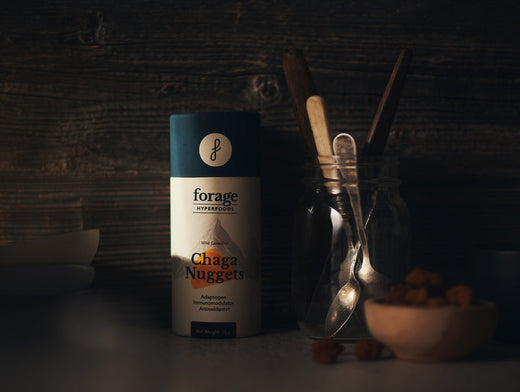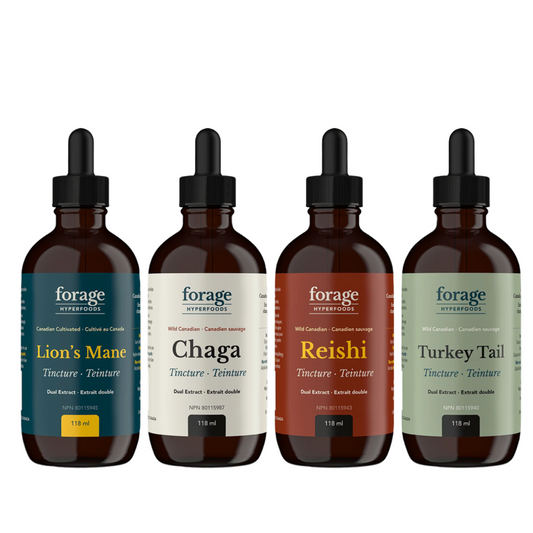All referenced sources are linked in the blog.

When Is the Best Time to Take Chaga?
Share
So, you’ve decided to try Chaga after hearing about all of the incredible health benefits it offers. Your next question is probably, “When is the best time to take Chaga?” We’re going to answer that question today, but before we do, let’s review what Chaga is.
What exactly is Chaga?
Although it’s typically referred to as a mushroom, Chaga (Inonotus obliquus) is actually a sclerotia—a hardened mass of fungal mycelium. As a parasitic fungus, Chaga primarily grows on birch trees in cold climates, like those in Canada, Siberia, Scandinavia, Russia, and some parts of the United States.
Chaga doesn’t pop up from the forest floor like most mushrooms. Rather, Chaga appears on birch trees as a black, charcoal-like mass (called a conk) with a woody, orange interior. Despite its unsightly exterior, the wide-ranging health benefits of Chaga more than make up for its lack of aesthetic beauty. Chaga is packed with antioxidants, vitamins, and minerals, making it a functional fungi powerhouse. It’s been shown to support a strong immune system, provide anti-inflammatory benefits, support heart health, promote good digestion, and potentially play a role in cancer prevention, just to name a few. One interesting theory is that Chaga’s many beneficial compounds may be a result of natural adaptations by the fungus to withstand the cold, harsh climate it grows in.
When is the best time to take Chaga?
Many people just starting out wonder when they can consume Chaga to best reap the benefits and most easily fit it into their lifestyle. Is it bright and early? Late at night? Good news: you can drink Chaga tea any time you’d like! However, there are a few key instances when consuming Chaga is extra beneficial.
When you are tired
Chaga is caffeine-free, and still a great source of natural energy. In fact, many people drink Chaga as an alternative to coffee in the morning, or during that mid-afternoon slump. Since it’s caffeine-free and can be enjoyed with or without food, Chaga can be consumed just about anytime you need a natural energy boost.
During flu season
The fall and winter months tend to be when colds and the flu go around. With such high levels of antioxidants and nutrients, it’s no wonder that one of Chaga’s most well-known health benefits is its ability to support immune health and fend off germs. Chaga is a source of beta-glucans (specifically beta-D-glucans), naturally-occurring polysaccharides that have been shown to possess strong immune-boosting qualities. Consume a cup or two of Chaga tea per day during the cooler months to support your immune system and keep you in tiptop shape.
When you are sick
Not only can Chaga help prevent you from catching a cold or the flu, it can also speed up your recovery time if you do get sick. Chaga is rich in betulinic acid, an alcohol soluble triterpenoid with anti-inflammatory, anti-viral, and potential anti-cancer properties. Research shows that compounds in Chaga mushroom slow biological action against several types of viruses and also prevent replication of various virus types. In a research setting, it has even blocked strains of herpes from entering cells. If you feel like you’re coming down with a bug, add some Chaga into the mix to get well soon, and stay that way!
Before bed
Since Chaga doesn’t have caffeine, you can also consume it before bed for a calming nightcap. While everyone reacts a little differently to medicinal plants, Chaga is unlikely to keep you awake because it’s considered an adaptogenic mushroom. That means it helps the body adapt to stress and restore normal bodily functioning. When you need energy, it provides you with energy, and when you need rest, it soothes you. In this way, Chaga can help relax your nerves and quiet your mind so you get a deep, restorative sleep.
Find a trusted source for your Chaga
Purchasing Chaga mushroom from a trusted supplier is the best way to ensure its effectiveness and safety. Not all Chaga products are created equal so be sure you’re getting yours from a company whose Chaga is organically grown, sustainably harvested, carefully extracted, and tested for quality and contaminants, such as heavy metals, pesticides, microbial contamination, and gluten. If a Chaga supplement lists any ingredients like “mycelium on grain” or other funky fillers, it's best to avoid it. To reap the full potential of this fungal powerhouse, seek a Chaga extract that uses wild-harvested Chaga.
The takeaway
There’s no need to think too much about when to take Chaga. It can be consumed whenever you want, year-round! While it’s fine to use it whenever you please, you might want to specifically consider using it during flu season to help ward off harmful bugs, when you’re sick to bolster your immune system, in the morning for energy, and before bed for relaxation. Most importantly, consume Chaga consistently! This is the best way to ensure that you’re receiving its incredible, wide-ranging health benefits.



